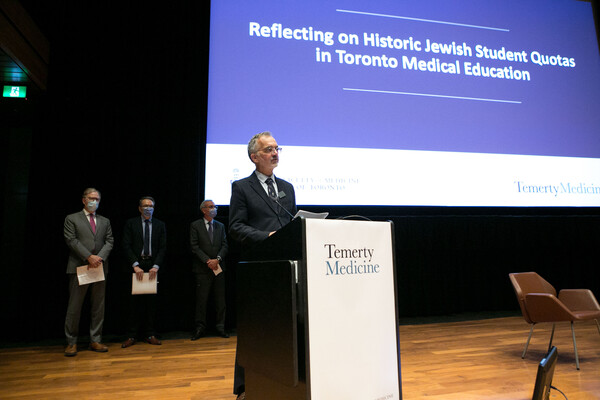Mobile Menu
- Education
- Research
-
Students
- High School Outreach
- Undergraduate & Beyond: Community of Support
- Current Students
- Faculty & Staff
- Alumni
- News & Events
- Giving
- About

 One of the privileges of working in academia is the opportunity to bring smart people together to work on difficult problems. Research funding. Graduate student pathways. Competency-based medical training. The complexity of each of these could inform multiple PhD theses — and that’s only a sampling of the many issues Faculty of Medicine leaders are championing.
One of the privileges of working in academia is the opportunity to bring smart people together to work on difficult problems. Research funding. Graduate student pathways. Competency-based medical training. The complexity of each of these could inform multiple PhD theses — and that’s only a sampling of the many issues Faculty of Medicine leaders are championing.
Cutting across all domains, however, is one particularly persistent challenge: the lack of advancement of women in academic medicine. In 1984, 43 per cent of U of T’s MD class were women. Many of these women went on to work not only in private practice but in academic medicine. Yet 30 years later, only 36 per cent of clinical faculty in the Department of Medicine, for example, are women and only 25 per cent of its full professors are women.
The mere passage of time is clearly insufficient to address sex and gender biases. We have a robust pipeline of women as medical trainees, how do we keep them from leaking out of our leadership pipeline?
Many private enterprises — banks, legal firms and other professional services — have stopped questioning whether this is an issue and how we got there but are instead increasingly taking on deliberate strategies to diversify leadership roles. Diverse teams make better decisions, are more productive, engage in the community and foster innovation. In short, it’s good for business.
So what are we doing in academic medicine? Hint: it’s not about quotas or lowering standards.
The issues are multi-factorial but at the core we need to actively create an environment of fairness and transparency. From search committees and job descriptions to informal networks and opportunities to take on the stepping stone roles that build leadership skills. Shining a light on all of these career elements — while understanding our own implicit biases and what we mean by “excellence” — will go a long way toward leveling the leadership playing field for all.
It’s about seeking out and valuing a diversity of opinions — and candidates. It’s about women actively role-modeling leadership: who presents at Grand Rounds, who are the keynotes at conferences, who are the committee chairs. Can emerging leaders and young women see viable paths forward to leadership? As leaders, do we spot and seek out talented women to develop leadership skills?
The Department of Medicine — under the leadership of Chair Gillian Hawker with Professor Sharon Straus and Diversity Office colleagues Professor Lisa Robinson and Anita Balakrishna — has been working deliberately and diligently on the gender talent gap and with strong results. At the department’s recent second annual Summit for Women in Academic Medicine, which drew physicians and surgeons from across Canada and into the US, Professor Hawker outlined many practical approaches her department has implemented, for example on search committees and job descriptions:
• Standardizing job descriptions and interview processes so everyone gets the same questions every time;
• Ensuring a diversity of voices in the formal structure of a search committee;
• Voting online after a committee meeting to rank-order candidates;
• Getting proactive and seeking out qualified leadership candidates who may not self-select.
This is work I am committed to doing at the Faculty-level as well. We are seeking out champions in every department. Advice and mentorship is important but so is advocacy; women alone can’t make system-wide change without men in power as allies. I am committed to developing and implementing best practices to track equity, inclusivity and diversity: what we don’t measure, we can’t be accountable for. And we will continue to educate our admissions and search committees on implicit bias and how to ensure fairness and transparency in decision-making.
An organization’s culture is a reflection of the values we bring to our work and what gets rewarded. Management guru Peter Drucker is long credited with saying “culture eats strategy,” meaning an organization must analyze its culture and either manage within that or, if necessary, change the culture. Change is what we’re making in medicine.
As educators, we all play a role in shaping the culture of our disciplines. Step up and have challenging conversations. Help your colleagues bring clarity and fairness to your processes. We aren’t always going to get it right but we can always be accountable.
Trevor Young
Dean, Faculty of Medicine
Vice Provost, Relations with Health Care Institutions


